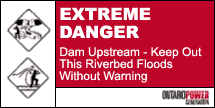Stay Clear, Stay Safe
Hydroelectric Dams and Stations are NOT Safe
Places for Recreation
There are dangers in coming too close to
hydroelectric dams and stations. A spot that
looks calm and safe one moment can become
dangerous within a few seconds as water levels
and flows change, often without warning. Calm
waters or a dry riverbed could change quickly
into one with rapidly moving, dangerous waters.
Most hydroelectric dams and stations are
remotely controlled by operators stationed many
kilometers away. Throughout the day and night,
as demand for electricity rises and falls
operators open and close dams, and start and
stop generating units. This results in frequent
and rapid changes in water levels and flows
around dams and generating stations, changes
that can affect the safety of those who venture
too close.
Waters in the headponds above hydroelectric
dams and stations and the waters below them are
particularly dangerous. At a generation station,
water from the headpond rushes into the station,
turning large turbines that produce electricity.
The water rushes out of the station, to join the
main stream of the river. At dams excess water
can be released through gates into formerly calm
or dry riverbeds below. At both dams and
stations, the fast-moving water creates
dangerous turbulence and strong undercurrents.
Even if you canít see a generating station or
dam, waterways upstream and downstream can still
be affected by their operations. Itís important
to be aware of the potential dangers caused by
changing water flows, and to stay clear of the
waters near stations and dams.
Hydroelectric dams and stations, and the
areas around them are:
- NOT parks
- NOT fishing holes
- NOT boating areas
- NOT swimming areas
- NOT camping sites or picnic areas
- NOT snowmobile or X-Country Ski areas
- NOT safe places for recreation
Obey all warning signs. Symbols show the
consequences of not staying clear.

For your own safety near a hydroelectric dam
or station, make sure that you:
- Obey all warning signs, fences, buoys,
booms and barriers. They are put there to
protect you. The areas inside are dangerous,
stay clear of them.
- Stay a safe distance outside of warning
signs, buoys, booms and barriers when
fishing, boating or swimming.
- Stay well back from the edge of waters
above and below hydroelectric dams and
stations
- Never stand below a dam, or anchor or
tie your boat there. Rapidly changing water
levels and flows can take you by surprise
and could swamp your boat or put you in the
grip of an undertow.
- Stay off hydroelectric dams or station
structures, unless OPG has clearly indicated
walkways, or observation points.
- Stay well back of dry riverbeds below
dams. They can quickly change into rapidly
flowing waterways.
- Stay well back from the edge of a
waterway where footing may be slippery.
- Donít wade into moving water.
- When swimming, fishing, boating or
paddling in a river, be aware of the water
level and check upstream frequently for any
sign of increasing currents or rising water
levels. If the water level is rising or the
flow is speeding up, get out of the water or
move your boat downstream. Even when the
hydroelectric dam or station is out of
sight, changing water levels and flows can
take you by surprise, pulling you into an
undertow, leaving you stranded away from
shore or swamping your boat.
- Set an example for children, who may not
be aware of the dangers, even if they can
read. State explicitly where they can and
cannot go and make sure you are close to
them and can see them at all times.
Winter poses additional dangers
Hydroelectric dams and stations operate all
year round, 24 hours a day. Their operation
affects water flows and ice conditions. Ice that
forms near a hydroelectric dam or station can be
thinner and more inconsistent than in other
locations because of the changing water flows
beneath it.
- Avoid snowmobiling, cross-country
skiing, skating or ice fishing on rivers or
lakes near dams and generating stations.
- Donít risk walking onto a river or lake
where the ice may be thin due to the current
or where changing water levels have pushed
water on top of the ice.
We take pride in operating our facilities
safely and in a manner that respects the
environment and the rights of other users of the
waterways. Your safety is important to us.
Please respect the hazards near our dams and
stations, and heed warning signs, booms buoys
and barriers. They are there for your
protection.
For more information about
safety
around hydroelectric dams and stations,
to obtain a free video, or free
interactive CD-ROM for children,
visit www.opg.com

